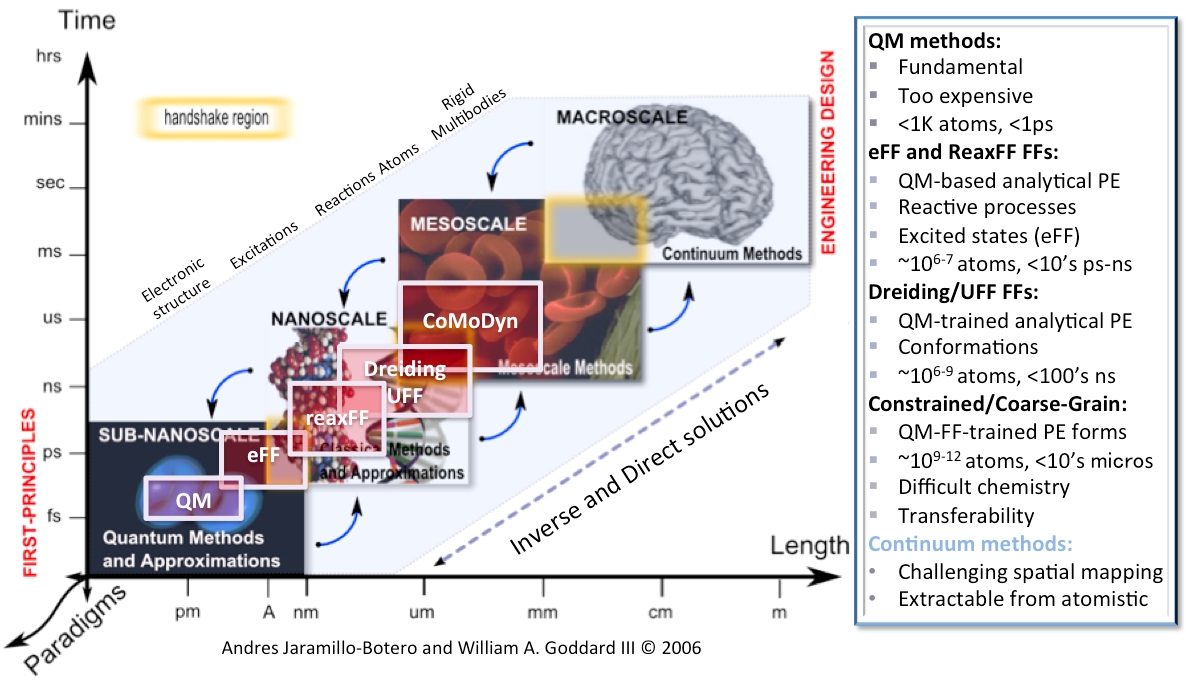|







| |

Figure above. Our Multiscale, Multiparadigm Simulation
Strategy |
Motivation and General Overview
Understanding natural phenomena
from science or optimizing processes from engineering requires, by today's
standard, synchronized contributions from theory, experiment and
computation. In an important number of cases, computer simulations
-based on fundamental theory- supplement experiment, but in many others,
they are the enabling tool for the study and comprehension of complex
systems and phenomena that would otherwise be too expensive or dangerous, or
even impossible, to study by direct experimentation.
|
|
| In principle, all properties of all
materials and phenomena are describable by quantum mechanics (QM)
[Schrodinger's equation],
unfortunately direct use of QM is impractical for solving
applications that involve a large number of atoms (> ~1K).
Classical and quantum-based, adiabatic and non-adiabatic, approximations to
Schrodinger's equation lead to simplified equations of motion [molecular
mechanics/dynamics - MM/MD] that are applicable to much larger systems while
still retaining the atomistic and electronic degrees of resolution
(~millions of atoms and electrons). Further classical approximations
on these systems include coarse-grain models based on rigid-bodies of
constrained particles, suitable, for example, in sampling the dihedral
conformational space of large-scale molecular systems, Monte
Carlo techniques, averaging and homogenization techniques to explore larger
and longer length- and time-scales, close to or within the mesoscale regime.
At the higher-end of the length- and time-scales, phenomenological-based continuum-level
methods [including, Finite Elements] are the norm, yet these are incapable of capturing fundamental nanoscale
properties and phenomena that are critical to understanding, elucidating and
optimizing the behavior of matter at the macroscale.
Our research
involves developing first
principles-based theory, methods and efficient multiparadigm computational
algorithms and tools capable of seamlessly bridging length and time scales
to enable de novo design, characterization and prediction of material
properties and processes and their application into solving currently
"impossible" problems. We also leverage and extend on other legacy
achievements at the MSC, including,
eFF
electron force fields,
ReaxFF reactive force fields,
Dreiding and Universal (UFF) non-reactive force fields,
CoMoDyn
constrained Molecular Dynamics, the
Computational Materials Design Facility (CMDF), among many others in
computational chemistry and physics. |
|
Recent
Milestones
 | 12/2011: We determine the atomistic mechanisms involved
that lead to electronic emission during high-strain rate brittle fracture
of Silicon using eFF |
 | 11/2011: We explain the effect of excited electrons on
the conductivity of high-pressure polyethylene using our non-adiabatic
dynamics methods |
 | 07/2011: We postulate the molecular origin of fracture
nucleation in Portland cement, from simulations using our new Ca/Al/H/O/S
ReaxFF reactive force fields |
 | 10/2010: Our reactive dynamics simulations reveal
possible composition of Enceladus' south pole plume, consistent with
Cassini's INMS data |
 | 03/2010: Experimentally validated dynamic shock
Hugoniots for Li metal, using explicit electron molecular dynamics |
 | 07/2009: Performed first large-scale (millions of
nuclei and electrons), long-term (10's ps), non-adiabatic excited electron
dynamics simulation of hypervelocity collisions |
 | 02/2009: Elucidated key mechanism involved in enhanced
mechanical response of DN hydrogels for tissue scaffolds |
 |
more ... |
|
|
What's New
 | 4/2019: Hypervelocity Sampling of the Solar System,NASA
Prime 80NM0018D0004 with JPL (PI: Morgan Cable) |
 | 12/2018: Multi-scale Approach to Study Properties of
VII Polymers in Solution, DOE Sponsored Research Agreement with Total
(France) |
 | 6/2017: STTR Phase I and II: Robust Molecular
Predictive Methods for Novel Polymer Discovery and Applications, Subaward
for DOE Prime DE-SC0017710 with PEER Institute |
 | 9/2016: Ultra-sensitive Opto-electrochemical Detection
of Liquid Explosives Fabrication, Subaward S-000878 for NATO Prime G5147 |
 | 10/2013: MARINE: Mass Analyzer for Real-time
Investigation of Neutrals at Europa (PI: Murray Darrach at JPL), JPL-NASA,
1493083 |
 | 07/2012: Intel (Santa Clara, CA) funds 2-year effort in
semiconductors [confidential] |
 | 9/2016: Ultra-sensitive Opto-electrochemical Detection
of Liquid Explosives Fabrication |
 | 01/2012: DARPA (US Defense Advanced Research Projects
Agency, Arlington, VA) funds seedling effort to study low-temperature
(<100C) thin film growth |
 | 04/2011: Dow Chemical (Spring House, PA) funds effort
for in colloids [confidential] |
 | 10/2010: NSF-MRI award (#1040558) funds large-scale
GPGPU cluster (32,256 Fermi cores) for soft matter simulations. 6
Caltech groups involved, including ours. |
 | 08/2010: Samsung (South Korea) funds modeling effort in
graphene-based nanodevices [confidential]. |
 | 06/2010: (DOT) Federal Highway Administration funds
collaborative effort to optimize the nano-mechanical response of
stone-based cement mixtures |
 | 03/2010: JPL-NASA collaborative effort on Cassini-Huygens
mass spectrometer impact ionization INMS data analysis |
 |
more ... |
|
|
|


![]()